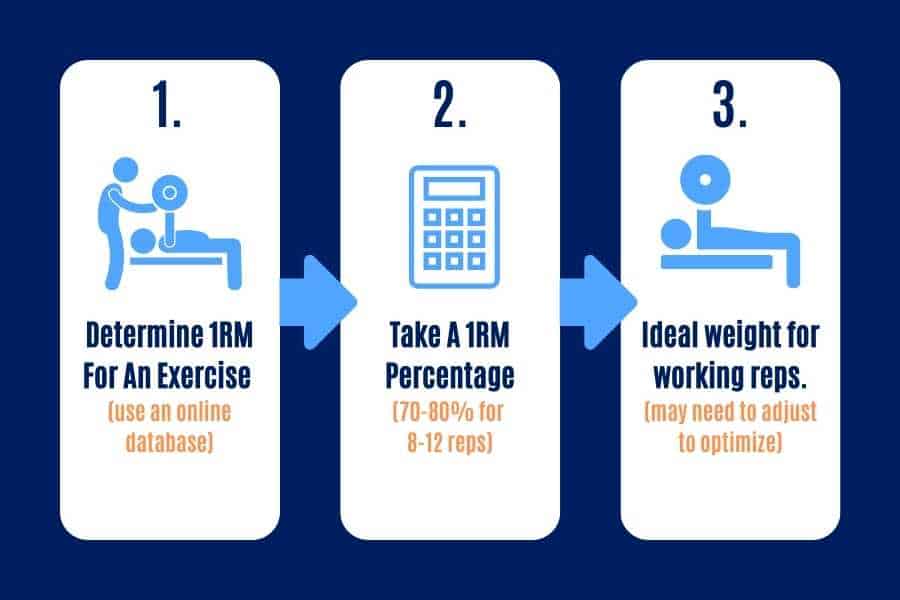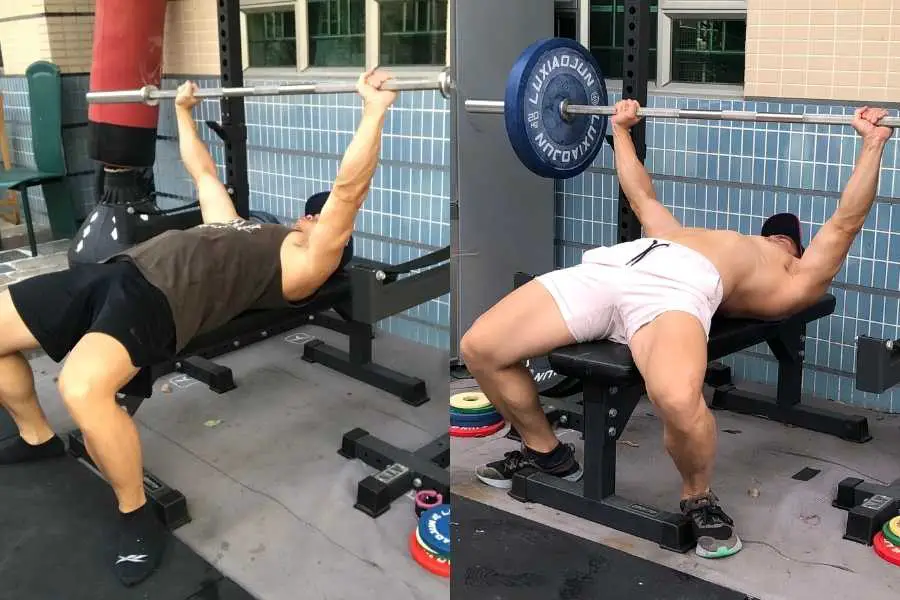Choosing a suitable weight is important for building bigger, stronger, and toned muscles. Why? Going too heavy increases the risk of bad form and technique. But going too light runs the risk of under-stimulation. Both instances lead to inefficient hypertrophy (muscular growth). So how much weight should you lift to build muscle?
The average person should lift a weight that is challenging for 8-12 consecutive reps to promote muscle growth. This equates to approximately 70-80% of the individual’s 1-repetition maximum (1RM). It is also essential to apply progressive overload by lifting heavier weights over time.
Below, I explain why the 8-12 rep range is so effective, how to use the 1RM method to choose the ideal weight for 8-12 reps, and how to overload for the fastest gains.
Key Takeaways:
- 8-12 reps are great for balanced gains in muscle strength, size, and endurance.
- Beginners can use ballpark weight recommendations to start working out.
- Use the 1RM method to calculate a more precise weight to lift for 8-12 reps.
- Determine your 1RM using an online database like Strength Level.
- Take 70-80% of your 1RM for a given exercise (this is the weight you should be lifting for reps).
- Overload regularly by increasing weight in small increments as you become stronger.

- General Starting Weights For Beginners To Build Muscle
- Using 1RM To Calculate The Ideal Weight To Build Muscle
- Ideal Rep Range For Building Muscle
- Signs You Are Lifting The Correct Amount Of Weight
- What To Do If A Weight Is Too Heavy Or Light
- How To Progressive Overload For Continued Muscle Growth
- Is It Better For Skinny People To Lift Heavy Or Light Weights For Muscle Gains?
- Conclusion
General Starting Weights For Beginners To Build Muscle
I wanted quick and simple recommendations when I was still a beginner. And I know may too!
The below table shows general starting weights for popular exercises that untrained beginners can begin using immediately in their next workout. Most newbies can safely lift the following weights for 8-12 reps (per set) and still find it relatively challenging.
Starting weight recommendations for beginners to build muscle:
| Exercise | Male Beginners | Female Beginners |
|---|---|---|
| Bench press (barbell) | 70lbs / 30kg | 20lbs / 8kg |
| Bench press (dumbbell) | 25lbs / 10kg | 7lbs / 3kg |
| Shoulder press (barbell) | 45lbs / 20kg | 15lbs / 7kg |
| Shoulder press (dumbbell) | 20lbs / 8kg | 7lbs / 3kg |
| Bent-over row (barbell) | 60lbs / 25kg | 20lbs / 8kg |
| Bent-over row (dumbbell) | 20lbs / 8kg | 7lbs / 3kg |
| Squat (barbell) | 95lbs / 45kg | 35lbs / 15kg |
| Squat (dumbbell) | 15lbs / 7kg | 5lbs / 2.5kg |
| Deadlift (barbell) | 110lbs / 45kg | 45lbs / 20kg |
| Deadlift (dumbbell) | 20lbs / 50kg | 9lbs / 4kg |
| Bicep curl (dumbbell) | 10lbs / 5kg | 5lbs / 2kg |
| Tricep extension (dumbbell) | 8lbs / 4kg | 4lbs / 2kg |
| Lateral raise (dumbbell) | 10lbs / 5kg | 3lbs / 1.5kg |
| Chest fly (dumbbell) | 10lbs / 5kg | 5lbs / 2kg |
Disclaimer- these are only general recommendations. In reality, your optimal lifting weight may vary greatly depending on factors including:
- Current fitness level.
- Previous training history.
- Body weight.
- Age.
- Rep range (it’s possible to build muscle outside the 8-12 rep range).
Next, I’ll show you how to determine a more precise weight to lift for the best muscle gains.
Using 1RM To Calculate The Ideal Weight To Build Muscle

You can use this 2-step method to determine the optimal lifting weight to promote muscle growth.
The first step is to establish your 1RM. The second step is to take a percentage of your 1RM to establish the weight for your working reps.
1) Determine Your 1RM:
A 1RM is the maximum amount of weight you can lift for a single repetition in any given lift. This varies greatly between different people and exercises.
The conventional method to calculate your 1RM is simple- lift as much weight as possible for 1 repetition (with the help of a spotter). Whilst effective, this method is not practical for most people (especially beginners).
The easier method is to use a reliable database like this one by Strength Level. It quickly estimates your 1RM for most exercises according to your body weight, gender, and training experience. The estimations are based on user-generated data and are relatively accurate.
2) Take A 1RM Percentage Using This Calculator
Next, taking a percentage of your 1RM gives you a good idea of the weight you should be lifting for a particular rep range (also called working reps).
Calculator to determine the ideal weight to build muscle in different rep ranges:
| Reps | Percentage Of 1RM |
|---|---|
| 1 | 100% |
| 2 | 97% |
| 3 | 94% |
| 4 | 92% |
| 5 | 89% |
| 6 | 86% |
| 7 | 83% |
| 8 | 81% |
| 9 | 78% |
| 10 | 75% |
| 11 | 73% |
| 12 | 71% |
| 13 | 70% |
| 14 | 68% |
| 15 | 67% |
| 16 | 65% |
| 17 | 64% |
| 18 | 63% |
| 19 | 61% |
| 20 | 60% |
Example Calculations
1. Let’s assume your barbell bench press 1RM is 100lbs and you want to perform 8 reps. Using the calculator, we take 81% to give a working weight of 81lbs. This is how much weight you should aim to lift for 8 reps to gain muscle.
Here’s another example.
2. Your dumbbell squat 1RM is 60lbs (30lbs per dumbbell) and you want to perform 12 reps. Using the calculator, we take 71% to give a working weight of 43lbs (roughly 22lbs per dumbbell). This is how much weight you should aim to lift for 12 reps to gain muscle.
Limitations Of This Method:
The 1RM method is much more accurate than the general beginner recommendations given at the start of this article.
However, it still isn’t 100% accurate.
For example- you may find that after using the calculator to establish an 81lb bench press for 8 reps, this weight is too difficult to lift.
Therefore it’s important to adjust the weight when you begin training. The goal is to adjust the weight until you’re lifting the ideal amount.
Ideal Rep Range For Building Muscle
A rep range is simply the number of consecutive reps completed per set. Broadly speaking, lower reps require you to lift heavier weights and higher reps require you to lift lighter weights. Studies indicate that all rep ranges can build muscle if completed to muscular failure (particularly for beginners).
With that being said, the general consensus is that different rep ranges are ideal for emphasizing different results, as follows:
| Rep Range | Weight | Repetitions Per Set | Primary Goal |
|---|---|---|---|
| Low | Heavy | 1 to 7 | Strength and power focus |
| Moderate | Medium | 8 to 12 | Strength, hypertrophy, and endurance (balanced) |
| High | Light | 13 to 20+ | Endurance focus |
Therefore lifting weights in a moderate rep range (8-12) is ideal for building muscle size (hypertrophy). However, simply lifting 8-12 reps alone is not enough. You also need to use a challenging weight that induces muscular fatigue in the allotted reps.
To do this, you can use the calculator in the previous section to work out a relatively precise figure.
If you’re interested, you can check out my other post for details on how long it takes to go from skinny to ripped!
Signs You Are Lifting The Correct Amount Of Weight

The main ways to tell you’ve chosen the right weight to lift:
- All reps are completed with good form. This means no cheat reps, half reps, and using body momentum to help you lift the weight.
- The last few reps in a set are challenging. For example, an increasingly greater “muscular burn” should be felt in reps 5-8 if you’re aiming to complete 8 total reps.
- Perceived exertion is moderately high. You feel your heart/breathing rate increase and you break a sweat.
- A muscle pump is present. Lifting weights in the 8-12 rep range (and above) usually induces a “pumped” feeling in the target muscle due to an increase in localized blood flow. This is usually felt as a noticeable (but not uncomfortable) tightness or swelling.
If you notice these signs during and after performing your working sets, then this is a good sign that you’re fatiguing your muscle and lifting the right amount of weight to drive hypertrophy!
Check out my other post for more signs that you are using too much weight!
What To Do If A Weight Is Too Heavy Or Light

Your overall aim for gaining muscle should be to lift in the 8-12 rep range using a weight that challenges you (use the above signs for reference). You may need to adjust the weight if you find it too heavy or light. Here’s how to do it:
- If the weight is too heavy- decrease in 5-10lb increments until you’re able to lift the weight with good form for the allotted reps.
- If the weight is too light- increase in 5-10lb increments until the weight is challenging for the allotted reps.
The method for adjusting weight varies depending on the equipment you’re using:
- Barbells- switch to a heavier/lighter weight if you’re using fixed barbells or add/subtract weight plates if you’re using loadable barbells.
- Dumbbells- switch to a heavier/lighter weight if you’re using fixed dumbbells or add/subtract weight if you’re using adjustable dumbbells.
- Resistance bands- use a thicker/thinner band.
You may also be interested in my other post to find out the optimal workout duration for skinny beginners to gain muscle
How To Progressive Overload For Continued Muscle Growth
Choosing the right weight to lift is just the start of the battle. You’ll also need to apply progressive overload for long-term muscle gains.
Put simply, overloading is the act of increasing exercise intensity over time as you get stronger. This ensures your muscles are constantly challenged and continually growing (check out my other post for the main signs of muscle growth).
The most popular way to overload is to simply lift heavier weights:
- Upper body exercises- add 2.5-5lbs.
- Lower body exercises- add 5-10lbs.
As a general rule of thumb, you should apply overload when your current reps begin to feel easy to complete. Most beginners should aim to do this at least once every 1-2 weeks.
Check out my other post to find out the ideal training frequency to gain muscle as a skinny beginner.
Is It Better For Skinny People To Lift Heavy Or Light Weights For Muscle Gains?

Beginners should use light weights first. As an untrained newbie, light lifting can still promote muscle growth. However, as this 2015 study shows, it’s crucial to complete each set to near-failure for the best hypertrophy benefits.
Using light weights also allows you to practice good lifting form as well as prepare your muscles with the necessary adaptations to start increasing weight through progressive overload.
With that being said, you should eventually move on to lifting heavier weights for low reps if you want to maximize muscle gains.
Why heavy weight lifting is ideal for building muscle and getting buff:
- Progressive overload is essential for muscle gain. You will quickly plateau if you don’t increase weight. That means stagnating muscle and strength gains.
- Mechanical tension drives hypertrophy. Heavier weights provide a greater mechanical tension stimulus to challenge your muscles for strength and size gains.
- Increased neuronal recruitment increases strength. Lifting heavy weights leads to increased neuronal recruitment. This allows you to lift heavier weights which helps you to build more muscle.
- Stabilizer muscles become stronger. Stabilizer muscles are the small muscles surrounding your larger muscles. Heavy lifting recruits these muscles and allows you to become stronger.
- Bone density increases. This study indicates that progressive overload and heavy resistance training can increase bone density. This can help skinny beginners lift heavier weights.
- Increased fast twitch-fiber activation. These are a type of muscle fiber that is particularly responsive to growth. They are activated by heavy lifting and explosive movements.
Note- the term “heavy” is subjective. A heavy weight for a beginner may feel like a light weight to a trained powerlifter.
For the purposes of this article, the term “heavy” describes a weight that is at least 60% of your 1RM.
You can also go to my other post for more details on why skinny people should lift heavy to build muscle.
Conclusion
Beginners looking to build muscle should aim to lift a weight that is challenging for 8-12 reps.
This varies from person to person according to individual fitness levels. The easiest way to determine your 8-12 rep weight is to first identify your 1RM and then take 70-80% (full methodology detailed in this post).
It’s also important to apply progressive overload by increasing weight over time. This will help you gain the biggest hypertrophy benefits.
You may also be interested in the downloadable Kalibre Blueprint PDF which details exactly how I gained 40lbs of lean muscle (it’s 100% free!). It details the exact exercises and nutrition (with printables) I used to go from skinny to ripped!


